 W
WUmayyad architecture developed in the Umayyad Caliphate between 661 and 750, primarily in its heartlands of Syria and Palestine. It drew extensively on the architecture of other Middle Eastern civilizations and that of the Byzantine Empire, but introduced innovations in decoration and new types of building such as mosques with mihrabs and minarets. It was also inspired by Islamic architecture, and they made mosques with vibrant colours and used geometric designs because representational art wasn't allowed.
 W
WAl-Aqsa Mosque, located in the Old City of Jerusalem, is the third holiest site in Islam. The mosque was built on top of the Temple Mount, known as the Al Aqsa Compound or Haram esh-Sharif in Islam, several decades after Muhammad's death. Modern Muslims believe that Muhammad was transported from the Great Mosque of Mecca to this location during the Night Journey. Islamic tradition holds that Muhammad led prayers towards this site until the 16th or 17th month after his migration from Mecca to Medina, when Allah directed him to instead turn towards the Kaaba in Mecca.
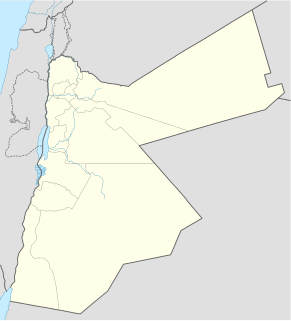 W
WThe Umayyad desert castles, of which the desert castles of Jordan represent a prominent part, are fortified palaces or castles in what was the then Umayyad province of Bilad al-Sham. Most Umayyad "desert castles" are scattered over the semi-arid regions of north-eastern Jordan, with several more in Syria, Israel and the West Bank (Palestine).
 W
WDome of the Chain is a free-standing domed building located adjacently east of the Dome of the Rock in the Old City of Jerusalem. It is one of many small buildings that can be found scattered around Haram ash-Sharif. Its exact historical use and significance are under scholarly debate. Erected in 691-92 CE, the Dome of the Chain is one of the oldest surviving structures on the Temple Mount.
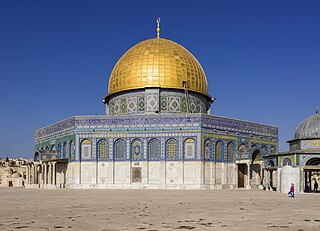 W
WThe Dome of the Rock is an Islamic shrine located on the Temple Mount in the Old City of Jerusalem. It was initially completed in 691–92 CE at the order of Umayyad Caliph Abd al-Malik during the Second Fitna on the site of the Second Jewish Temple, destroyed during the Roman Siege of Jerusalem in 70 CE. The original dome collapsed in 1015 and was rebuilt in 1022–23. The Dome of the Rock is in its core one of the oldest extant works of Islamic architecture.
 W
WThe Great Mosque of Aleppo is the largest and one of the oldest mosques in the city of Aleppo, Syria. It is located in al-Jalloum district of the Ancient City of Aleppo, a World Heritage Site, near the entrance to Al-Madina Souq. The mosque is purportedly home to the remains of Zechariah, the father of John the Baptist, both of whom are revered in Islam and Christianity. It was built in the beginning of the 8th century CE. However, the current building dates back to the 11th through 14th centuries. The minaret in the mosque was built in 1090, and was destroyed during fighting in the Syrian Civil War in April 2013.
 W
WHammam al-Sarah is an Umayyad bathhouse (hammam) in Jordan, built in connection with the complex of Qasr al-Hallabat, which stands some 2 kilometres (1.2 mi) to the west. Along with examples in the other desert castles of Jordan, it is one of the oldest surviving remains of a Muslim bathhouse.
 W
WKhirbat al-Minya, also known as Ayn Minyat Hisham (Arabic) or Horvat Minnim (Hebrew) is an Umayyad-built palace in the eastern Galilee, Israel, located about 200 meters (660 ft) west of the northern end of Lake Tiberias. It was erected as a qasr complex, with a palace, mosque, and bath built by a single patron.
 W
WThe Great Mosque of Kairouan, also known as the Mosque of Uqba, is a mosque situated in the UNESCO World Heritage town of Kairouan, Tunisia and is one of the most impressive and largest Islamic monuments in North Africa.
 W
WThe Mshatta Facade is the decorated part of the facade of the 8th-century Umayyad residential palace of Qasr Mshatta, one of the Desert Castles of Jordan, which is now installed in the south wing of the Pergamon Museum in Berlin, Germany. It is part of the permanent exhibition of the Pergamon Museum of Islamic Art dedicated to Islamic art from the 8th to the 19th centuries. This was only a relatively small section of the full length of the facade, surrounding the main entrance; most of the wall was undecorated and remains in situ.
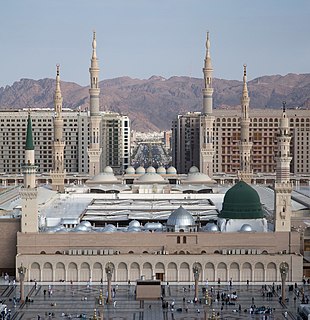 W
WAl-Masjid an-Nabawi, known in English as The Prophet's Mosque, and also known as Al Haram, Al Haram Al Madani and Al Haram Al Nabawi by locals, is a mosque built by the Islamic prophet Muhammad in the city of Medina in the Al Madinah Province of Saudi Arabia. It was the second mosque built by Muhammad in Medina, after Masjid Quba'a, and is the second largest mosque and second holiest site in Islam, both titles ranking after the Masjid al-Haram in Mecca. It is generally open regardless of date or time, and has only been closed to visitors once in modern times, as Ramadan approached during the 2020 COVID-19 pandemic.
 W
WThe Al-Omari Mosque is an early Islamic-era mosque in the Roman city of Bosra, Syria. It was founded by Caliph Umar, who led the Muslim conquest of Syria in 636 CE, and it was completed in the early 8th century by Caliph Yazid II. The mosque was renovated in the 12th and 13th century CE by the Ayyubid dynasties.
 W
WQasr al-Hayr al-Gharbi is a Syrian desert castle or qasr located 80 km south-west of Palmyra on the Damascus road. The castle is a twin palace of Qasr al-Hayr al-Sharqi, built by the Umayyad caliph Hisham ibn Abd al-Malik in 727 CE. It was built in the Umayyad architectural style.
 W
WQasr al-Hayr al-Sharqi is a castle (qasr) in the middle of the Syrian Desert. It was built by the Umayyad caliph Hisham ibn Abd al-Malik in 728-29 CE in an area rich in desert fauna. It was apparently used as a military and hunting outpost. The palace is the counterpart of Qasr al-Hayr al-Gharbi, a nearby castle palace built one year earlier. It is one of the so-called desert castles.
 W
WQasr Kharana, sometimes Qasr al-Harrana, Qasr al-Kharanah, Kharaneh or Hraneh, is one of the best-known of the desert castles located in present-day eastern Jordan, about 60 kilometres (37 mi) east of Amman and relatively close to the border with Saudi Arabia. It is believed to have been built sometime before the early 8th century AD, based on a graffito in one of its upper rooms, despite visible Sassanid influences. A Greek or Byzantine house may have existed on the site. It is one of the earliest examples of Islamic architecture in the region. Its purpose is hard to ascertain with any degree of certainty.
 W
WQasr Mshatta is the ruin of an Umayyad winter palace, probably commissioned by Caliph Al-Walid II during his brief reign (743-744). The ruins are located approximately 30 km south of Amman, Jordan, north of Queen Alia International Airport, and are part of a string of castles, palaces and caravanserais known collectively in Jordan and the wider Southern Levant region as the Desert Castles. Though much of the ruins can still be found in situ, the most striking feature of the palace, its facade, has been removed and is on display at the Pergamon Museum in Berlin. The complex was never completed.
 W
WQusayr 'Amra or Quseir Amra, lit. "small qasr of 'Amra", sometimes also named Qasr Amra, is the best-known of the desert castles located in present-day eastern Jordan. It was built some time between 723 and 743, by Walid Ibn Yazid, the future Umayyad caliph Walid II, whose dominance of the region was rising at the time. It is considered one of the most important examples of early Islamic art and architecture.
 W
WAr-Rahman Mosque is a contemporary mosque in Aleppo, Syria, located on King Faisal Street. It was opened in 1994 and features a combined style of the early Umayyad architecture and modern mosques.
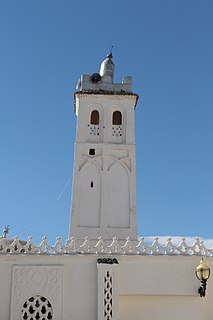 W
WSidi Okba Mosque is the oldest surviving mosque in Algeria. The mosque was first established as the mausoleum in 686 dedicated to ʻUqbah ibn Nāfiʻ, a Companion of the Prophet and one of the prominent commanders of the Muslim conquest of the Maghreb. The mosque has witnessed many renovations since then.
 W
WSolomon's Stables is an underground vaulted space now used as a Muslim prayer hall by the name of El-Marwani Mosque, some 600 square yards in area, at the bottom of stairs which lead down from the al-Aqsa Mosque, under the Temple Mount, to the base of the southern wall of the Temple Mount in Jerusalem. Solomon's Stables are located under the southeastern corner of the Temple Mount, 12.5 m (41 ft) below the courtyard, and feature twelve rows of pillars and arches. In December 1996 the Waqf converted the area into a prayer hall by adding lights and floor tiles, and renamed it the El-Marwani Prayer Hall.
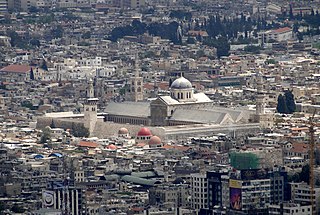 W
WThe Umayyad Mosque, also known as the Great Mosque of Damascus, located in the old city of Damascus, is one of the largest and oldest mosques in the world. The mosque is also important in Islam because of its historical and eschatological reports and events associated with the mosque. The mosque is the fourth holiest site of Islam.
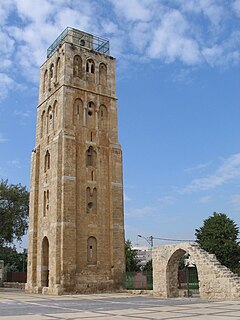 W
WThe White Mosque is an ancient Ummayad mosque in the city of Ramla, Israel. Only the minaret is still standing. According to local Islamic tradition, the northwest section of the mosque contained the shrine of a famous Islamic Prophet, Nabi Salih.